Telling customers about price hikes can pay off, despite consumers’ inflation woes.
Prolonged inflation has consumers on high alert. Our research shows that full transparency from retailers beats silence on this topic—for both their bottom line and their customer relationships—but there are risks.
In fact, retailers that informed customers of price hikes were more than seven times as likely to see an increase in unit sales, as well as boosts across several other business performance indicators, compared to those that raised prices without informing customers.
Below, we’ll explore what retailers have experienced after informing customers about price increases.
key findings
Telling customers about price hikes brings volatility: Retailers that informed customers about raising prices were more than seven times more likely to see increased unit sales, compared to those that didn’t tell customers. On the other hand, they were also more than five times more likely to see increased customer attrition.
Gratitude goes a long way: 43% of retailers that informed customers of price increases went on to increase their unit sales. The majority included a “thank you” to customers in their communication campaign.
Successful retailers use a variety of communication methods: 50% of successful price-increase communication campaigns used more than three channels to reach customers, most commonly social media, email, and website copy.
Successful retailers made modest price changes: 61% raised prices by 20% or less, and 36% raised them by 10% or less.
Informing customers of price hikes has pros and cons
Amid today’s inflation and rising prices, Gartner says retailers should give consumers what they want: early and clear communication about price changes, with transparency about where their purchasing dollars are flowing[1].
This leaves business leaders with a dilemma: Be forthright about raising prices and receive negative attention, or raise prices quietly and risk angering loyal customers even more if and when they take notice.
In our study, retailers that raised prices on goods and services over the past 12 months and informed their customers about it were significantly more likely to see improvements across several business performance indicators than those that raised prices but did not inform their customers (non-informers).
Despite announcing the bad news, these retailers saw increases in unit sales, revenue, profit margin, social media engagement, and new customer acquisition.
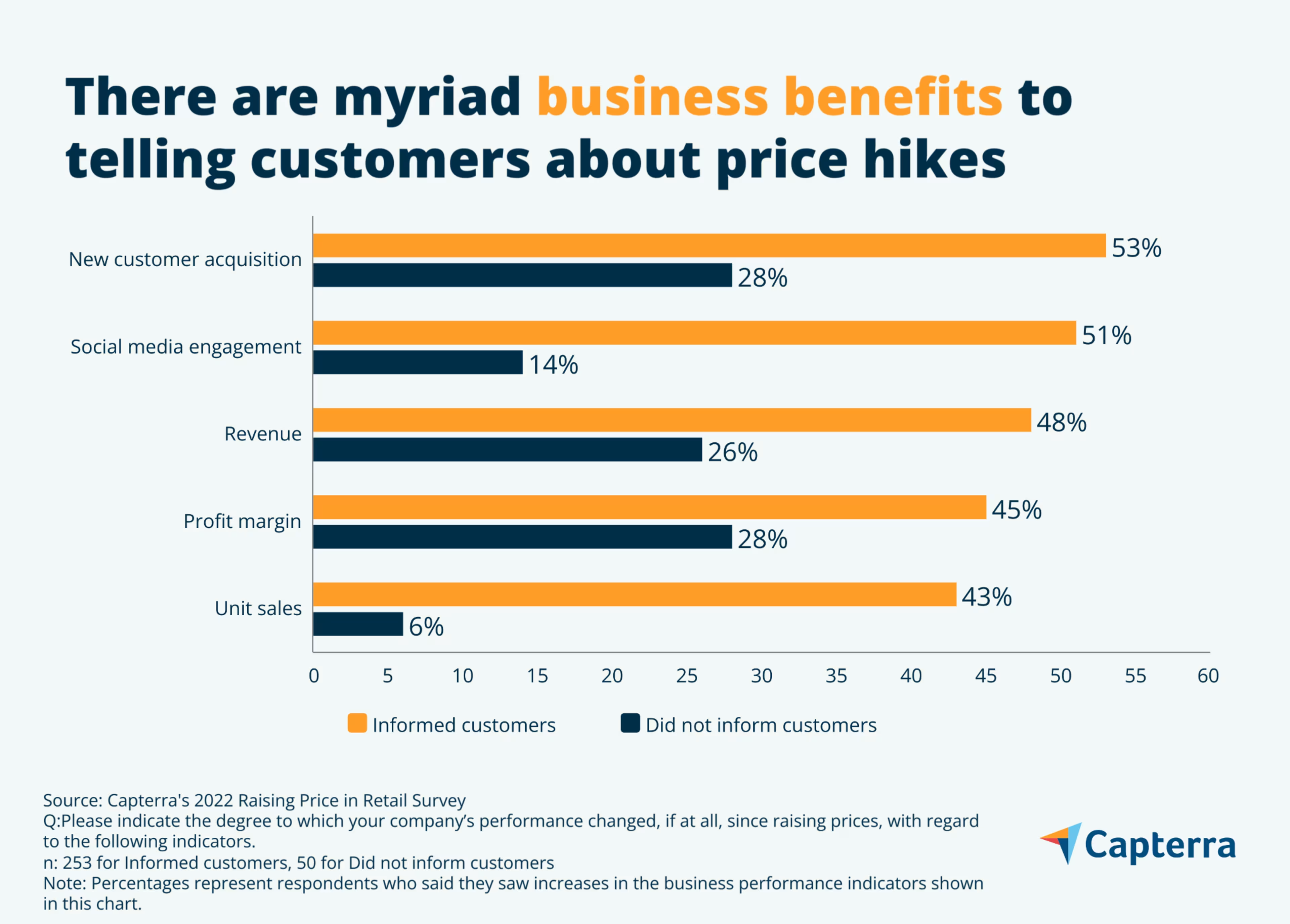
However, honesty about price hikes is a double-edged sword: Retailers that informed customers were more likely to also experience negative impacts following their price increases.
For example,
42% saw higher customer attrition following the price increases
41% received more negative customer feedback
41% took on more business debt (versus just 16% of non-informers who say the same)

Retailers that didn’t tell their customers about raising prices were not necessarily better off. They were significantly less likely to report any change—good or bad—in business performance following the price increase:
78% saw no change in social media engagement
68% did not see a rise or fall in negative customer feedback
66% say their unit sales held steady compared to before they raised prices
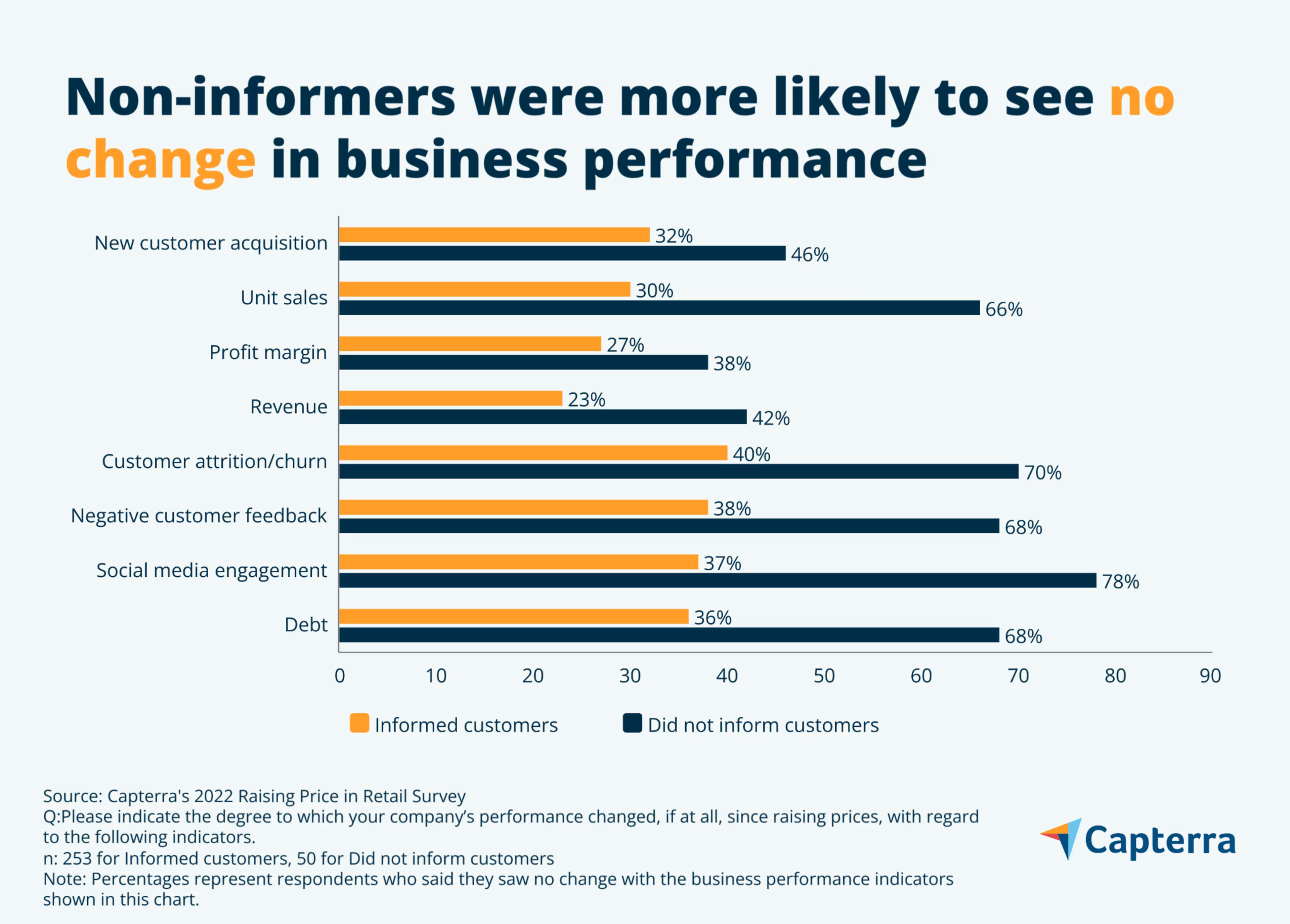
Not to be overlooked is the long-term value of an honest rapport with customers. Transparency is especially important for small businesses, which tend to benefit from being seen as neighborly and authentic.
While raising prices quietly might look like the safer choice in the short term, eventually customers will notice the new prices. They may view the lack of communication as intentionally deceptive, leading them to shop with competitors that appear more trustworthy—and leading the offending business to an uphill PR battle. Whereas a larger enterprise might have the margins to withstand a prolonged backlash to sneaky price hikes, a small business is much more vulnerable to shifts in consumer sentiment and purchasing choices.
In essence, informing customers about price changes is more likely to introduce volatility to a retail business than if they raise prices without notice. But if done right, communicating with customers gives retailers a greater chance of earning more money after prices rise—an increasingly crucial win for small businesses as inflation climbs to decades-high levels.
The bottom line is that there are both positive and negative consequences from being forthright about price hikes, on the customer experience front as well as the business performance front. This suggests that retailers need to consider their unique position in the market as well as their specific customer relationship dynamics when deciding whether to reach out.
The anatomy of a successful price increase communication campaign
Retailers looking for guidance on how to navigate inflation-related price changes should look to one group of retailers in particular: the 43% who communicated price changes to their customers and then saw increased unit sales.
Retailers in this group also saw financial success beyond unit sales. Nearly three-quarters (73%) also saw increased revenue following their price increase, 73% saw a boost in new customers, and 66% increased their profit margins.
Let’s examine how these successful retailers spun bad news into better performance, so you can use winning strategies in your own price increase communication.
Modest price increases that keep pace with customers
Successful retailers made modest price changes: 61% raised prices by 20% or less, and 36% raised them by 10% or less.
Roughly two-thirds of successful retailers kept their new prices level with or below those of their competitors, while roughly one-third raised prices above their competitors’. Those priced above their competitors were more likely to see increased business debt, as well as an increase in new customers.
Gratitude and transparency
Many successful retailers featured similar language in their campaigns. Over half made sure to express gratitude toward their customers, and 48% provided a reason or explanation for the price raise. Forty-two percent verbalized a commitment to not raise prices further or spelled out strategies they would take to avoid further price increases. Over a quarter offered their customers a deal as part of their campaign.
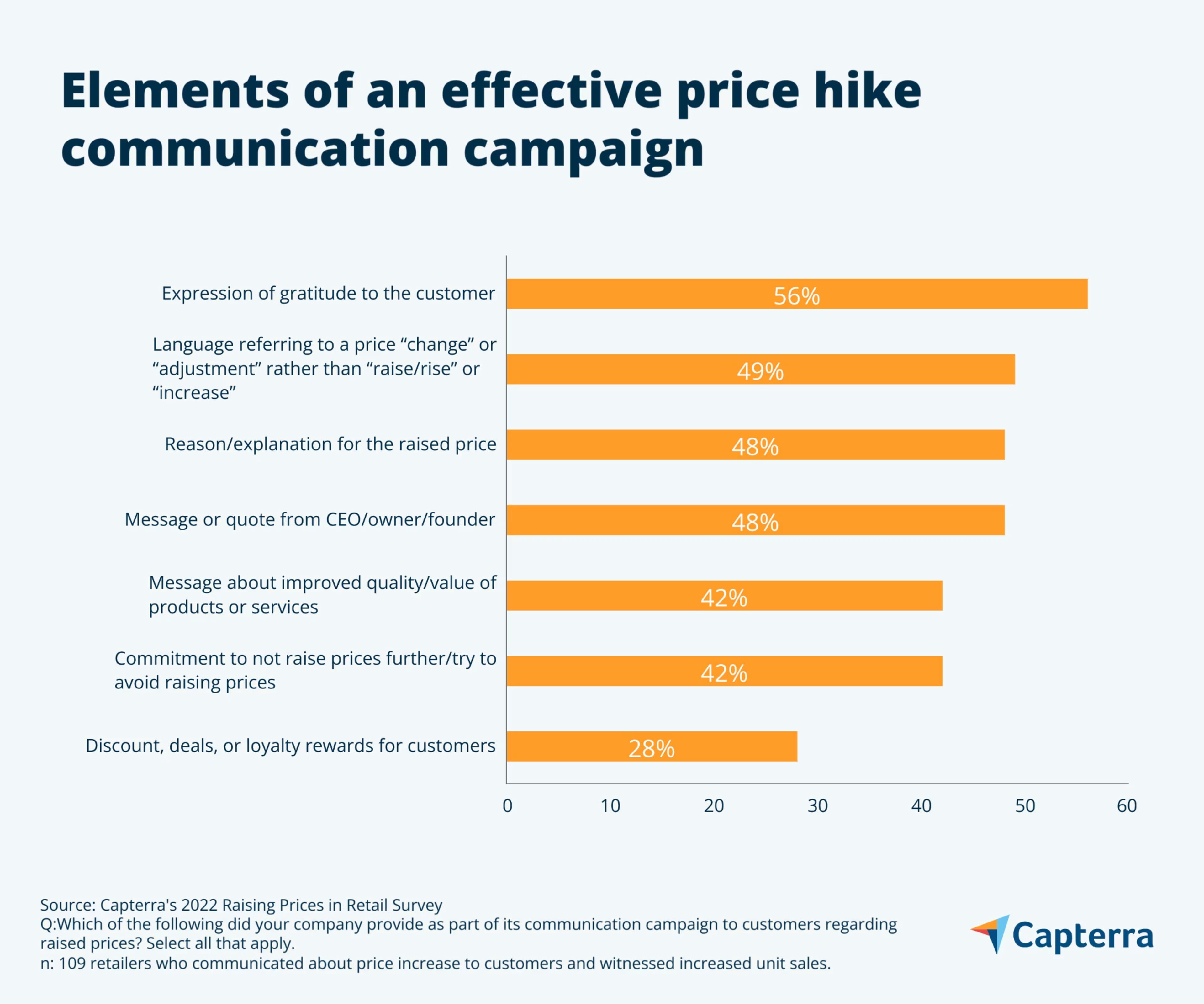
Advance notice
The vast majority of this group chose to inform customers before prices rose, rather than waiting around to do so—just 3% of successful retailers sent notice one month or later after raising prices.
With advance notice, customers can take time to adjust their expectations rather than experiencing sticker shock—and making a more stressful purchasing decision—the next time they shop with you.
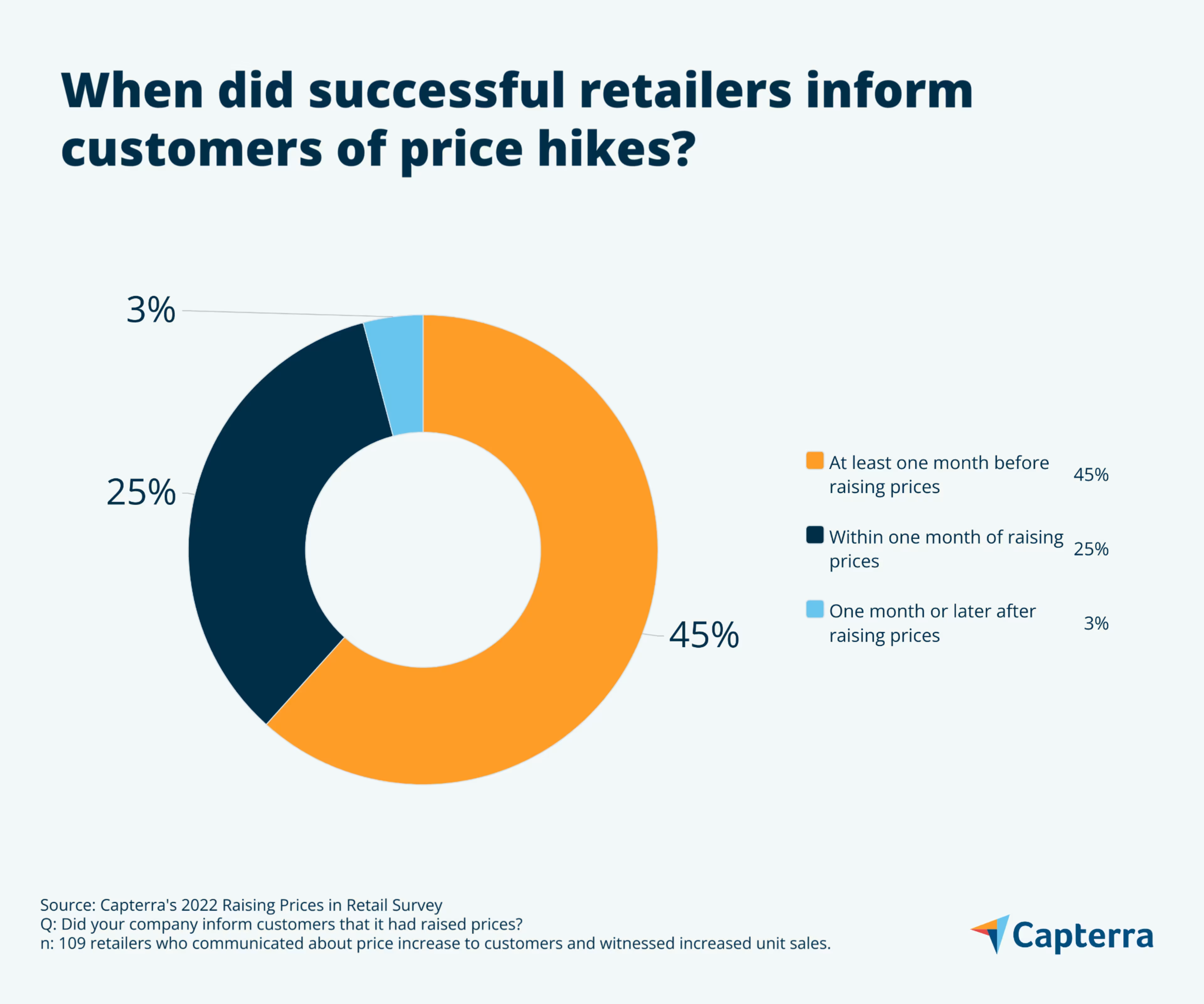
Multiple communication channels
Successful retailers used diverse channels to inform their customers about price increases. The majority chose to inform customers via branded social media posts, email, and/or adding messaging to their websites. Forty-four percent sent text messages and 29% sent direct mail to customers.
Eighty-nine percent used more than one channel, and 50% used more than three.
Using a mix of short- and long-form communications, such as website pop-ups, text messages, and emails, gives retailers multiple attempts to reach their audience with the method that best suits each customer’s preference.
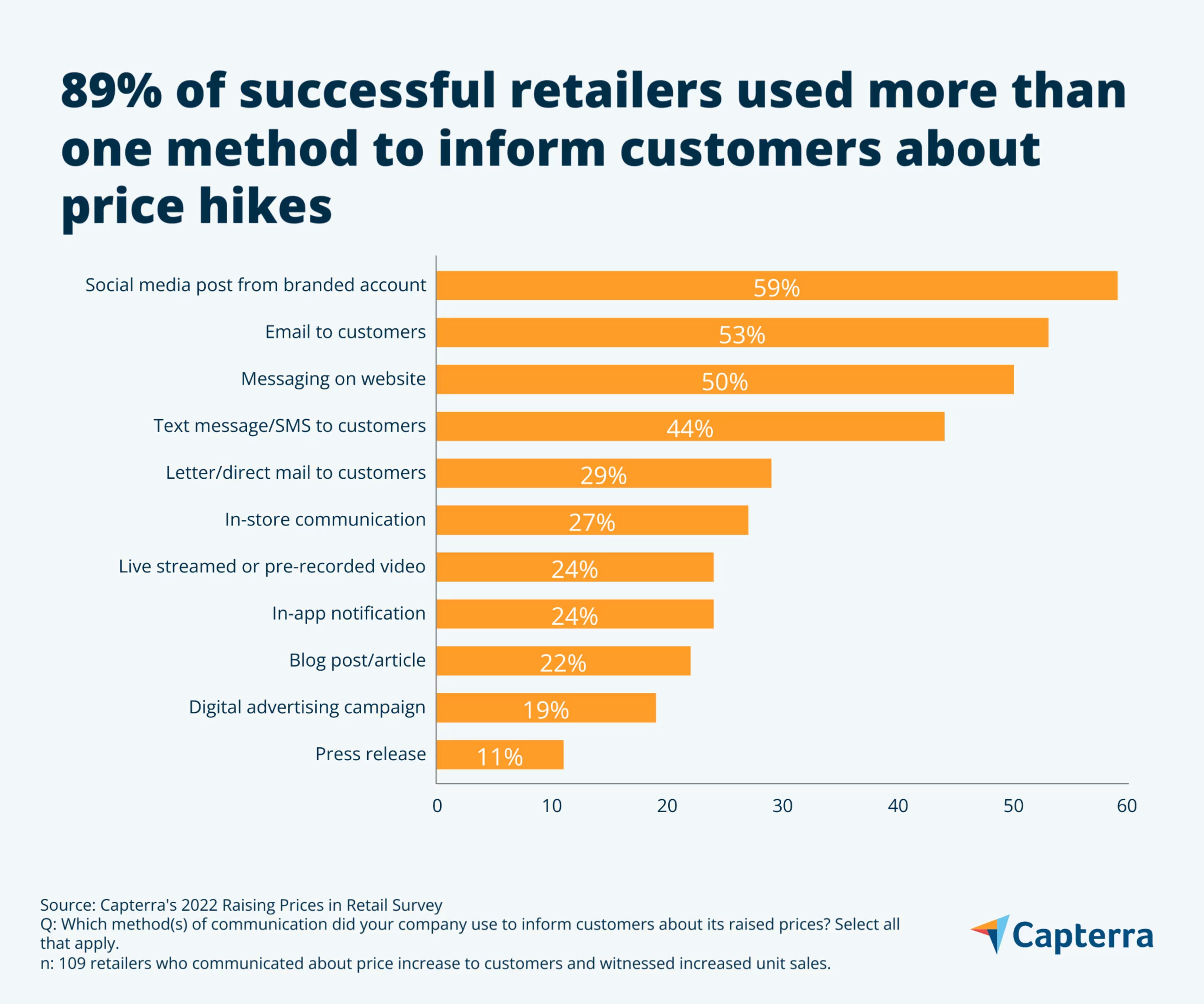
When notifying customers of price changes, anticipate turbulence
To be sure, factors beyond well-crafted correspondence may have contributed to this group’s success. For one thing, roughly six in ten (62%) retailers have been in business for at least six years. This successful group did not include any brand-new businesses with less than one year of operations. At least 95% of these retailers sell both online and in-store, perhaps serving broader audiences and insulating themselves against big losses.
Additionally, for each of the negative effects tracked in this study, over half of successful retailers saw an increase. For instance, 56% of successful retailers also saw increased customer churn following their price increases, 52% saw a rise in negative customer feedback, and 52% incurred more business debt following the price increases.
When raising prices and notifying customers, retailers should expect some turbulence as customers react to the change. But by being transparent with their audience, businesses can set themselves up for future success despite the bad news.

